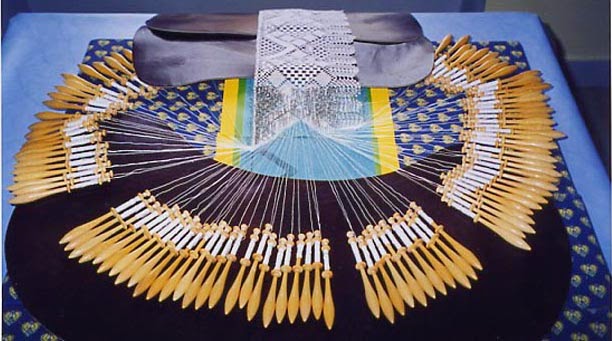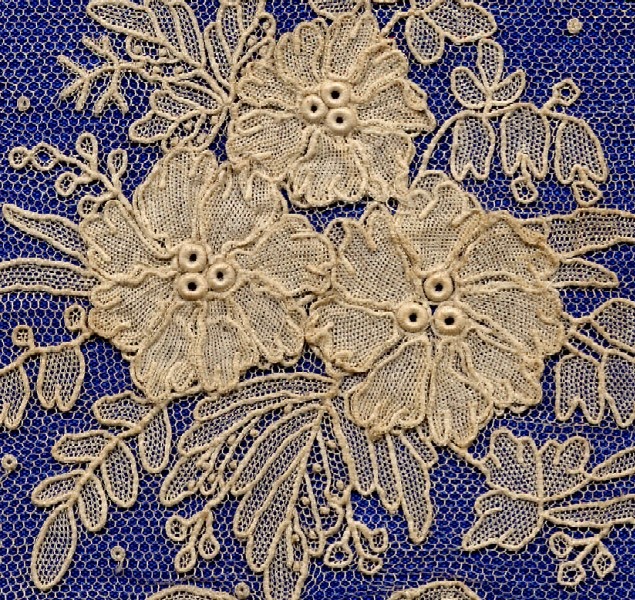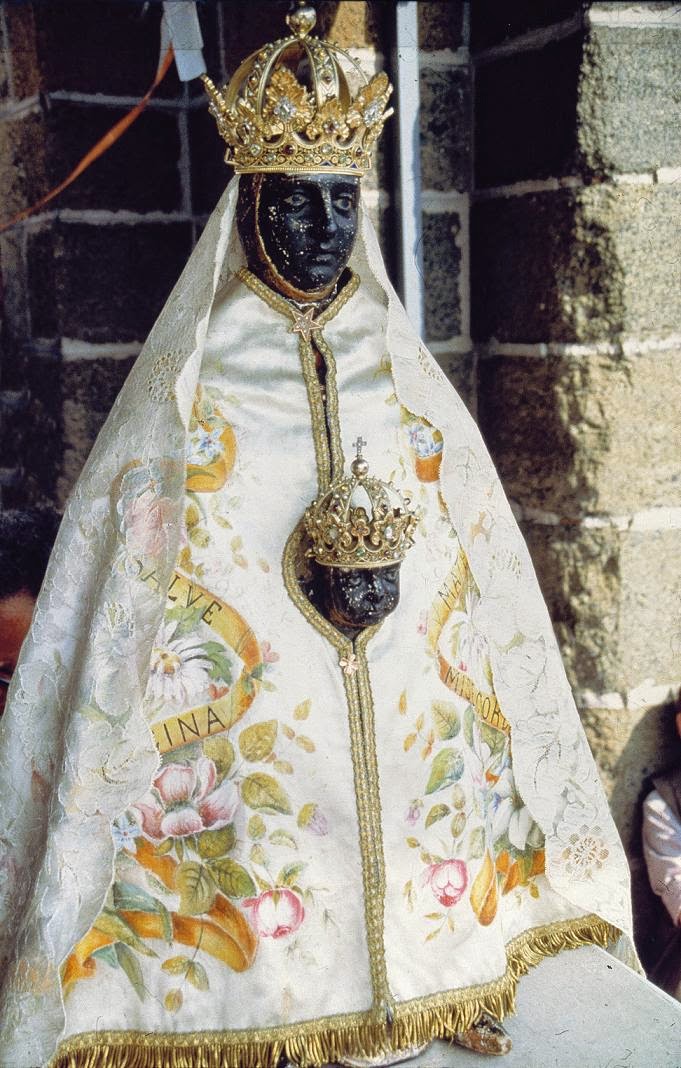Le Puy en Velay is a French commune, located in the department of Haute-Loire and Auvergne. Its inhabitants are called, in French, ponots. Until March 18, 1988 the name of the city was simply Le Puy. By the way, my cousin Fernando live there with her wife Cécile. I envy you Fernando.
Originally inhabited by the Celtic tribe of the Vellaves, the Romans settled in the area, which they called Anicium and lead to Podium Aniciense, hence its current name.
During the Middle Ages suffered, like all the French Midi (Southern France), wars of religion that were particularly harsh and violent. The city remained affects to the Catholic camp while the surrounding lands adhered Reform. It was also at this time when pilgrimages were initiated. On one side it was the destination of Le Puy Marian pilgrims. On the other it was one of the origins of the Camino de Santiago de Compostela (Way of Saint-Jacques of Compostelle). These movements, possibly initiated in the tenth century, became very important in the XII century.
French Revolution arrived. It was not well accepted by the local population who remained faithful to their religious values and monarchy. The population was, for a long time, opposed to the Republic. Between March 1793 and January 1795 were guillotined in Le Puy forty-one people, including eighteen priests. Also was destroyed the Black Madonna, the Marian image that originated the first pilgrimages.
Between 1856 and 1860 under Napoleon III, was built with the metal of 213 Russian guns captured in the Crimean War, a large statue painted in pink of the Virgin, which continues in Le Puy: the image of Notre-Dame de France.The statue weighs 835 tons and is 23 metres high. If you want to go you have to be in very, very, very good health. You have to walk to the top of vulcano Rocher Corneille and from there walk another 260 steps up a spiral stair case. This Napoleon Three, as in French call him (English, more monarchist, would say: Napoleon, the Third), should have been an athlete.
Being in Paris the best way to go is via the train #TGD6681 that leaves from Gare de Lyon (Place Louis Armand, Paris 12, Metro Lines 1 and 10) at 6:57, Tue, Wed, Thu, Fri and Sat. This train arrives to St. Etienne Chatea at 9:47. Change to the train #TER89956 that leaves St. Etienne Chatea at 9:54 and arrives to Le Puy en Velay at 11:16. Total journey time with changes is about 4 hrs 20 mins. You can have a light breakfast in the first train to St. Etienne Chatea or in Gare de Lyon, being there enough in advance to be quiet. Go with light baggage, it's better. Bingo, you are in Le Puy en Velay ready to enjoy your visit.
Zero stress my friends. We will spend the night here, all together. Book your stay online in advance. When I tell you in advance it's really in advance. Normally they have all booked even two or three months before. Have a look to TripAdvisor for Hotels, Vacation Rentals and Bed and Breakfast. Leave your baggage where you will stay and go immediately to know the city. Wear walking shoes and do not carry anything heavy because you are going to walk and climb a lot. If you have cardiac problems avoid going where it is necessary to climb like Cathedrale Notre-Dame and Chapelle St. Michel d'Aiguilhe.
First place to visit is the Tourist Office. Here you will find maps of the town and three tours: a standard tour of two hours, a grand tour of three hours and a night tour of two hours. It is located at 2 place du Clauzel 43000.
Rising from the foot of the volcano Rocher Corneille in the highest point of the city is The Cathédrale de Notre Dame, a national monument of France. It contains architecture from the V to the XV century but the bulk of the building is from the first half of the twelfth century.

"La Vierge Noire" or Black Virgin is located on the main altar. It's a long story as all stories of France. It seems that there was a Black Madonna by the tenth century or even before. When King Louis IX, future Saint Louis, visited the Cathedral in the year 1254 the virgin had dissapear. The king offered a new statue to the cathedral which remained until 1794 when French Revolution removed and burned. Current (see photo above) is a new one dating back to 1856. All August 15 there is a procession through the streets of Le Puy with the statue of the Virgin Mary.
Photo of the cloister by Jean-Pol GRANDMONT.

This photo is beautiful and I borrowed from VirtualTourist but I didn't find a link to the author. His name is pfsmalo, thinking it's a soubriquet.

| Tire? Want to walk and climb more? Let's go to Saint-Michel d'Aiguilhe (Perhaps Saint-Michel of the Neddle, in English). Located at the top of a rock it is accessible through a partially excavated staircase of 268 steps. The first construction of the chapel is from 969, although it has been rebuilt many times suffering profound stylistic changes.
The church was built in the volcanic rock formation, easy to carve itself. It has a lobed arch adorned with a characteristic architecture of the Umayyad Caliphate of Córdoba, which lasted in the French Romanesque architecture through the influence of the pilgrims along the pilgrimage routes to Santiago de Compostela and in particular along the Via Podiensis, through Aiguilhe. This photo by BaboMike (again some sort of soubriquet) explain better than nothing the enormous challenge that you must take to be there. I'm not going. I wait for you here having a beer and watching beautiful people, specially women, walking around. See you later, alligator. |

|
Le Tour Pannessac (Pannessac Tower) is one of the most beautiful historical ruins of the fortified city that was once Le Puy en Velay. In the thirteenth century could be counted eighteen towers in the wall way of the city. Pannessac is the only survivor of the original eighteen. Its twin was sadly demolished in 1850 to widen the entrance to the street. God, how can be destroyed these monuments! Wasn’t there another way to widen the blessed street?

In the past, the twins were the place where great battles were staged. It is always interesting imaging how was the place some centuries ago.

Close to the rock of Aiguilhe, we can find the octagonal chapel of Saint Clair, from the XII century. It was dedicated to Saint Clair in the seventeenth century and declared historical monument in 1887. It was the mortuary chapel of the old hospital of Saint Nicolas d’Aiguilhe, founded in the late eleventh century which welcomed the pilgrims who came to Notre Dame.
For a long time the fate of Saint Clair was discussed and for this reason it is still called "Temple of Diana". At the symbolic level, the presence of the Temple of Diana at the bottom of the rock is due to a cosmic analogy. Diana, a deity who embodies the moon, is in the bottom of a rock dedicated to a solar deity, as the moon is at nadir when the sun is at its zenith. For the sanctuary to be completed, it is necessary that the two polarities of worship were present.

|
A few kilometers from Le Puy en Velay we can find Espaly Saint Marcel to visit the Shrine of Saint Joseph. In this place were founded the Sisters of Saint Joseph in the year of 1650. It’s a huge and beautiful white statue surrounded by a park.
This congregation began with six women gathered in a small kitchen in Le Puy and motivated by the common desire to serve God and the poor in their community. These ladies, with the spiritual direction of a Jesuit priest Jean-Pierre Medaille, formed the first community. Some early accounts attribute the foundation of the order to the younger brother of Father Medaille, Jean-Paul Medaille. Currently has about 14,000 members worldwide: 7,000 in the United States, 2,000 in France and the rest in another fifty countries. |
About 5 km from Le Puy en Velay, we can find Le Forteresse de Polignac, perched on a volcanic hill that offers a breathtaking spectacle. From its platform you can enjoy an unprecedented panoramic view of the region. The fortress inspired and attracted famous visitors: Georges Sand place at the fortress the action of one of her novels (despite the male name it was actually the pseudonym of Amandine Aurore Lucile Dupin, Baroness Dudevant, French writer), Le Marquis of Villemer, and Prosper Mérimée, writer and first inspector of historical monuments, classified it as a historic monument in 1840. It is an exciting journey through the remains of the fortress that leads the visitor to explore this magnificent place.

About 30 km from Le Puy en Velay you can visit Chavaniac La Fayette, the castle where was born Marie-Joseph Paul Yves Roch Gilbert du Motier, Marquis de La Fayette, known as La Fayette (b. September 6, 1757, Castle Chavaniac-Lafayette, Haute-Loire department of Auvergne - f. May 20, 1834, Paris).
He was a French military and political. La Fayette was a general in the War of Independence of the United States which is considered one of the heroes. Influential figure of the French Revolution until 1792, was a member of the General Assembly and commander of the National Guard of Paris. Also he was responsible for the security or even better, jailer of King Louis XVI, who was finally beheaded by the Revolution in 1793.
The visit takes an hour through a guided tour. The castle grounds are beautiful. Not bad life gave these revolutionaries. You will know the halls and rooms of the castle, La Fayette's bedroom, and will see much of the eighteenth and nineteenth centuries furniture. You will also know the story of this great man, friend of George Washington, and colaborator in the independence of the United States.

As souvenirs you can lead Le Lentille Verte du Puy (The Green Lentil of Le Puy), Le Verveine du Velay (Green Velay Verbena), and La Dentelle de Puy (The Laces of Le Puy).
The Green Lentils of Le Puy is a specialty from Le Puy en Velay. It has a designation of origin from 1961 and a Protected Designation of Origin since 2008. It occurs in a well defined area, located in Haute-Loire in the highlands of Velay (altitude of 600 to 1,200 meters). A unique microclimate prevails: the grain suffers a cold early and after the summer sun, which speeds ripening. The production is artisanal, ie, fertilizers or irrigation. Planting takes place between March and April and harvest from 1 to September 15.

The liquor Verveine du Velay was created in 1859 by Joseph Rumillet-Charretier, passionate herbalist, apothecary genial and probably a little alchemist. Given its high quality and exquisite flavor, the liquor soon acquired letters of nobility and became a recognized digestive. In 1886, Victor Pagès, Rumillet cousin, took over the distillery to which he gave his name.
The Verveine du Velay has been included in the assets of the Province, gastronomic and architecturally, since its elegant building set in the district of Saint-Jean in the heart of Le Puy en Velay.
The Verveine du Velay continues preparing according to the same recipe since 150 years ago. The art of making this liquor is in the process of soaking and maceration of 32 species of plants, including the verveine. The mix is distilled in red copper stills and finally aged briefly in oak barrels. This liqueur has been made in Le Puy by the family Pagès since 1886. If you can read in French here is the recipe to make your own liquor.

|
 |
Already established and thriving in Velay in the sixteenth century, the production of lace fell sometime in the seventeenth century, following a judgment of the Parliament of Toulouse prohibiting manufacture. What stupid idea, I say, prohibiting people to work and produce. The Jesuit Jean-François Régis contributed greatly in recovery making lobby among politicians, because he was a great devotee of lace.

Under Colbert, Minister of King Louis XIV, the industry flourished again when was founded the Institution of Ladies for Instruction that taught the art among young girls.

After the vicissitudes of the Revolution, the lace industry made great strides in the nineteenth century. By 1860 there were 130,000 lace workers in Haute-Loire for 300,000 inhabitant! After 1900 there was a significant decrease of handmade lace in favor of mechanization.

Thanks to the efforts of Theodore Falcon in 1903, the manual industry has improved with the creation of the Dentelle Départemental Conservatoire à la Main in 1941, the Centre d'Enseignement de la Dentelle au Fuseau in 1974 and L'Atelier Conservatoire National de la Dentelle in 1976. If you want to study this technical visit The Education Center. There are distance courses.

For eating there are very good restaurants in Le Puy en Velay. Better of them require reservation for having dinner. Check carefully links I'm giving here: Maki Nova rated number one in Le Puy by Trip Advisor is a restaurant with French and Japanese influences around sushis. Range price: $20-34. Le comptoir des saveurs rated number two in Le Puy by Trip Advisor. French food. Range price: $11-43. They say from themselve: "A gap of the historic center, you will be greeted with conviviality for a moment of relaxation to discover cuisine flavors and originality. It takes our new decor in a restaurant that has obtained the title of Master Restorer". Francois Gagnaire Restaurant rated number three in Le Puy by Trip Advisor. French food. Certificate of Excellence 2014. Le Comptoir Du Pic rated number four in Le Puy by Trip Advisor. It's a wine bar. By june 2014 has 5 reviews all of them ranked Excellent. L'Ame des Poetes rated number five in Le Puy by Trip Advisor. Authentic memorable cuisine says a last review by june 2014. There are 79 more to select according to Trip Advisor. Have a look here.
Le Puy en Velay
Do not miss
- Best Towns in France
- Baume les Messieurs
- Dinan
- Cassis
- Sainte Eulalie d'Olt
- La Roque Gageac
- Sainte-Agnès
- Lyons-la-Fôret
- La Bastide Clairence
- Gordes
- Yèvre-le-Châtel
- Locronan
- Preparing your trip to Paris
- Visiting Île de la Cité
- Where to find the best France Tour
- Group Travel vs Single Travel
- How to be happy in Le Moulin Rouge
- A medieval day in Bruges
- Holiday Apartments in Europe
Ce blog est une fenêtre à travers laquelle le monde anglophone peut voir votre entreprise. Forfait à partir de 10 euros par mois, pas de clic ou impressions. Écrivez-moi si vous êtes intéressé. Ci-dessous, un formulaire de contact.

